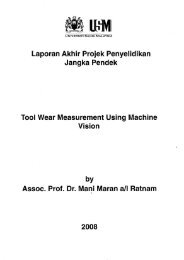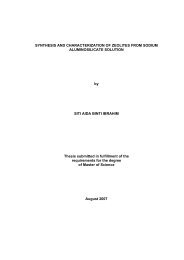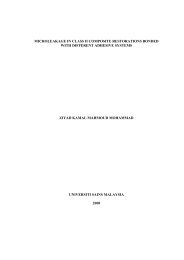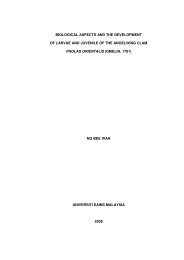a study on the performance of limestone roughing filter - ePrints@USM
a study on the performance of limestone roughing filter - ePrints@USM
a study on the performance of limestone roughing filter - ePrints@USM
Create successful ePaper yourself
Turn your PDF publications into a flip-book with our unique Google optimized e-Paper software.
educti<strong>on</strong>s <strong>of</strong> coliform organisms without using any chemicals (Wegelin, 1986; WHO,<br />
2004). The advantage <strong>of</strong> horiz<strong>on</strong>tal flow <strong>roughing</strong> <strong>filter</strong> is its extended bed lengths and<br />
solid storage capacity, resulting less cleaning frequency. The disadvantage includes<br />
large space requirement.<br />
Upflow <strong>roughing</strong> <strong>filter</strong> can generally be divided into two types, upflow <strong>roughing</strong><br />
<strong>filter</strong> in series and upflow <strong>roughing</strong> <strong>filter</strong> in layers. An upflow <strong>roughing</strong> <strong>filter</strong> in series is<br />
similar to <strong>the</strong> downflow <strong>roughing</strong> <strong>filter</strong>. The difference is that water will flow upward<br />
through each media compartment. Although upflow and downflow <strong>roughing</strong> <strong>filter</strong>s<br />
perform similarly, upflow <strong>roughing</strong> <strong>filter</strong>s are recommended for ease <strong>of</strong> cleaning<br />
(Wegelin, 1996).<br />
Upflow <strong>roughing</strong> <strong>filter</strong> in layer c<strong>on</strong>sist <strong>of</strong> <strong>on</strong>e <strong>filter</strong> box, with multiple layers <strong>of</strong><br />
<strong>filter</strong> media, ranging from coarse media at <strong>the</strong> bottom to fine at <strong>the</strong> top and water flows<br />
in upward directi<strong>on</strong>. The advantage <strong>of</strong> this <strong>filter</strong> is that it has much lower space and<br />
cost requirement than o<strong>the</strong>r types <strong>of</strong> <strong>roughing</strong> <strong>filter</strong>s.<br />
In general, optimal treatment in <strong>roughing</strong> <strong>filter</strong>s can be achieved by using more<br />
individual compartments. That means, a 3 stage <strong>roughing</strong> <strong>filter</strong> is expected to perform<br />
better than a 2 stage <strong>roughing</strong> <strong>filter</strong>. Upflow <strong>roughing</strong> <strong>filter</strong>s are more efficient in solid<br />
removal than o<strong>the</strong>r types <strong>of</strong> <strong>roughing</strong> <strong>filter</strong>s (Cleary, 2005). However, since vertical flow<br />
(upflow or downflow) <strong>roughing</strong> <strong>filter</strong>s have a smaller <strong>filter</strong> depth compared to horiz<strong>on</strong>tal<br />
flow <strong>roughing</strong> <strong>filter</strong>s, it is recommended that vertical flow <strong>filter</strong>s should be limited to<br />
treating raw water with turbidities less than 150 NTU (Wegelin,1996).<br />
2.5 Filter Materials<br />
Graham (1988) described that <strong>filter</strong> material originally used in <strong>the</strong> <strong>roughing</strong> <strong>filter</strong><br />
was gravel, later it was replaced by any inert, clean, insoluble and mechanically<br />
10

















